During one of my daily BoardGameGeek website visits, I came across Paperback, a game by designer Tim Fowers. It was only on Kickstarter, with a few people receiving and playing prototypes. Advertised as a Scrabble-like deck builder, I knew I had to back it. I’ve been playing Scrabble with my family since I was a kid, and I figured this was something I could enjoy with my parents. About six months after the Kickstarter, I received Paperback in the mail. I had completely forgotten that I’d ordered it, so talk about a pleasant surprise! I managed to play two games of it since then, and you can read my thoughts in this review. Currently, the only way to buy this game is to find it on auctions, or pre-order the second printing. You can order it here (click me!), and I strongly encourage it if it seems like something you’d enjoy. Once pre-orders reach 500, the printing will proceed, and you will not be charged until that goal is reached. But I have no doubt it will happen.
Also, this is a special review because I am co-hosting/co-reviewing with Mr. Richard Ham of Rahdo Runs Through! I’m a huge fan of his videos, and I can’t believe I am getting the opportunity to collaborate with him. Thanks to Richard, my wallet has suffered from buying the games he features on his channel. I can’t say I mind, though my mom is a bit annoyed at the stacks of board games taking over the house. C’est la vie! There is a great interview at the end of this review, and once Richard posts his video and final thoughts, I will include them in this post. [Edit: the videos are now below!] Meanwhile, check out his run throughs on YouTube by clicking the link in this paragraph.
This review also will be different because I am trying out a slightly new format. Let me know which you like better in the comments – just check past tabletop reviews for comparison. I’m always trying to improve, so feel free to give constructive criticism 🙂 Now, on to the review! As always, click on the images to enlarge them.

Overview:
Game: Paperback
Designer: Tim Fowers
Artist: Ryan Goldsberry
Publish Date: 2014
Players: 2 to 5 gamers, ages 8 and up
You’ll like this if you like: Scrabble, Dominion, Boggle
Rules/Gameplay: (or skip ahead to my review)
In the rulebook, Paperback is described as such: “You are a group of paperback novelists trying to complete novels for Fame! The player with the most Fame at the end of the game wins.” Pretty simple concept and cute theme, but more on that later. At its heart, Paperback is a word game, like Scrabble, reimagined as a deck builder. For those unfamiliar with the concept of a deck builder, you are essentially using the cards in your hand to purchase other cards that you will add to your deck. These cards can be powerful and come with special abilities; as you play with the same deck throughout the game, the cards you purchased will come into play during future turns. So a deck builder is just that – building your deck of cards!
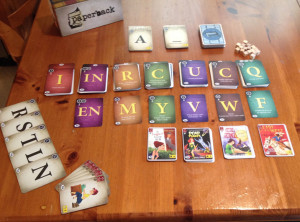
In Paperback, players start off by setting up the letter marketplace, which consists of various colored cards with letters on them. Each card has a different price, from two cents up to ten cents, and also a score number on the upper left corner. There are also fame cards, which look like book covers, and cost up to 17 cents; these cards give you the most fame points. Then there are common cards, which I will discuss in a moment. Each player gets a starting deck, consisting of five wild cards that can represent any letter, and five R, S, T, L, and N cards. The wild cards do not give you any points, but they are worth one fame point at the end of the game. The other cards in your hand are not worth any fame, but give you one point toward purchasing new cards from the marketplace.
On each turn, a player performs their actions. The first is to shuffle your deck, and draw five cards to create your hand. You then rearrange the cards in your hand to form a word. For example, if you drew an R, L, wild, wild, and S, you could make the word RAILS. You would put your word on the table and score points. Since wild cards are not worth any points, your word score would be three – one point each for R, L, and S. With your three points, you can look in the letter market and purchase a card that costs three cents. If, during a later turn, you score eight or nine points, you could buy as many cards as you like that equal that cost – such as two four-cent cards. Cards purchased are worth more points. Once you purchase your new card, add it to your hand, and place that hand in your discard pile. The next player performs the same actions. When it is your turn again, you take the remaining five cards in your deck, play and score, buy a new card, and once again add the purchased card to your hand. You would then discard that hand, and shuffle all your cards to start over. You are always pulling five cards per turn from your deck.
I mentioned the common cards before. This is a special deck that shows one letter at a time. Players can use this letter in forming their words, and it is worth one point. These cards are usually vowels, and they also have fame points attached to them. You can add these cards to your hand by creating words that are the specified length on the length track. The length track is placed under the common cards, starts off at seven letters, and goes up from there. So if you make a seven-letter word, you can take that common card and add it to your hand. Then a new common card is shown, along with a longer word length (I believe the next one is eight, but it might be nine – the game is packed away, so not sure).
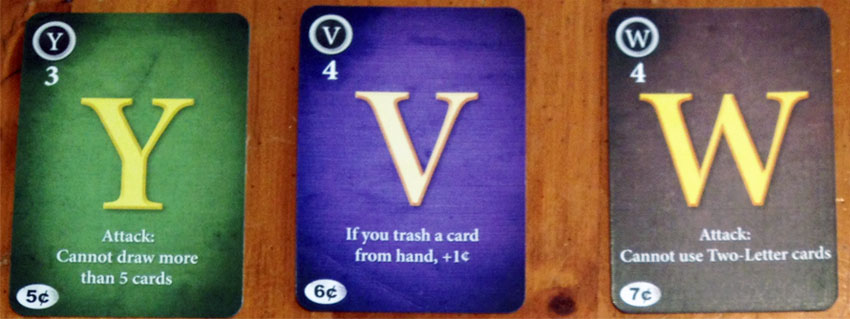
Cards in the marketplace can have special abilities attached to them. Some allow you to add extra points to your word score, buy cards for free, trash cards, or attack your opponent. The attack abilities may limit your opponent’s next hand (so they have to draw four cards instead of five), or some other equally vicious move. The game also comes with expansion cards that are optional in the game. One such card allows you to create two words per turn, while another allows you to reverse the letters on a two-letter card. There is also a cooperative variant included in the rules.
The game ends when two Fame card piles are emptied, or the common card pile runs out. Players score all the fame points in their deck, and the player with the most fame wins!
What I liked:
First of all, Ryan Goldsberry did an amazing job with the artwork. Besides the mechanics, the art is what really sold me on this game. It has this retro vibe, which I love, and the Fame cards are just adorable. So clever, as each book on the fame cards represents a different literary category, like sci-fi, Western, and romance. And they are all written by one Paige Turner, which is hilarious. The letter card design is clean, with vibrant colors and big easy-to-read text – they function perfectly. The quality of the cards are thick, and easy to shuffle – there is a nice texture to them.

The storage system for Paperback is creative, and so useful in keeping everything organized. Each card type is separated by taller cards with labels on them. Everything fits in this fairly small box. The lid purposely doesn’t close all the way, which is unique, but some might find that annoying – I certainly don’t. Also, when you lay the box on its side, it looks like a stack of books! I love that, because I can put it in my bookshelf, where it looks nice. So I guess you could say the box itself is very thematic 🙂
Paperback is a fantastic gateway game. You could teach this to just about anyone, as most people understand the concept of word-building from Scrabble or Facebook’s Words With Friends. While many hardcore gamers tend to scoff at gateway games (which actually annoys me, but that’s a blog for another time), this is one that can appeal to every level of gamer. There’s a lot to think about on each turn, but the play itself is very simple and elegant. I played this with my mom, whose is fairly new to tabletop gaming, and she loved it.
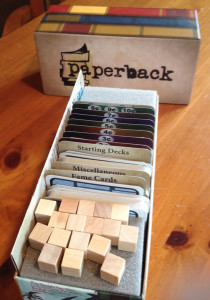
And most importantly, I liked this game because it is FUN. I can’t stress that enough. You will have a blast playing this, especially if you like word games. That’s the whole point of gaming for me – to have a good time doing something with people you love, or people you just met. Gaming brings people together in a way that is increasingly devalued in today’s age of social media and the internet. So yes, Paperback is fantastic – but it is not without its weaker points. Which brings me to…
What I didn’t like:
Okay, so maybe that’s a misnomer. Well, there are things I didn’t like, but some things I mention aren’t necessarily bad – just not for me, or they may bother some people, or they make the game more difficult for disabled players. I guess the main issue some could have with Paperback is its length. The game I played with my mom was over two hours, which didn’t bother me, as we just left it on the table to finish the next day. Long games don’t annoy me if they are fun. But Paperback is definitely prone to analysis paralysis, and if you have more than two players, it could take even longer. Like Scrabble, thinking of a word can take some time – but on top of that, you also have to think about what you want to do with your word score. As I said, though, that’s part of the fun. It’s like a small puzzle you have to solve every turn. There are some work-arounds for this, which Richard will probably discuss in his video, but I still think this game will take a while to play. Then again, each gamer has different ideas for what constitutes a long game.
One thing I definitely didn’t like was the rule book. Maybe I was really tired that day, or not in a learning mood, but I found this book to be very confusing. For example, the rules keep mentioning the “length track,” but nowhere in the rules does it say what the length track is. There is no rule for what happens when someone makes a bad word. I had to go on BoardGameGeek to clarify many things. I also think this game is ripe for house rules, which isn’t necessarily a bad thing, but I would have preferred more clarity. This was also my first deck builder, and I believe this rule book assumes you have played them before. Like I said, this may just be a case of my brain not computing that day, but it’s worth mentioning.
Another con that I noticed was the theme. Sure, the artwork is cute, but this game is purely abstract. The theme of being a novelist struggling to become famous just doesn’t come through at all. I’m big on theme, but with this game, I wasn’t too bothered by it because it’s so much fun. Also, the artwork makes up for it. I’m easy to win over like that! But I think it would have been cute if they took the wooden cubes included in the game (for the variant rules) and made them little bookmarks or typewriter keys – but I guess that has to do with production costs. Speaking of the variant rules, I don’t know if they add much to the game – although I have a feeling Richard will disagree with me here. I feel the game works best as it is meant to be played (minus what I talk about next), without the extra stuff.
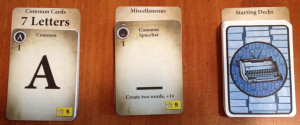
One other potential issue is the attack abilities on the cards. My mom and I both felt they were a tad unnecessary in an otherwise fun game. I don’t want to have “got you!” moments in a game that is more-or-less low key on the competition scale. I mean, there are moments when your opponent buys the card you were hoping to get on your next turn, but it’s akin to when someone takes your spot on Scrabble. It’s more of an unintentional, innocent dick move, you know? The attack cards here are more evil. However, the rules state that you can just not use the attack abilities – it doesn’t affect gameplay at all.
The Gimp Glimpse:
So on to disability issues/positives with Paperback. Firstly, this game can be a great learning tool for various cognitive disabilities. I think that is one of its greatest qualities – it can offer a lot in the classroom. I can totally see this being played in middle schools, and even high schools. I’m a big supporter of using tabletop games to teach, and this hits the nail on the head.
For the physically disabled, the main challenge is handling the cards. I can’t list this as a negative, since it is a card game, but I think it is important to point that out. Using a card holder for this game is kind of a pain, because you are constantly shuffling, rearranging, and switching out your cards. It is doable, especially if you have someone to help you, but just keep it in mind.
Finally, there are some issues here for the colorblind. Some of the cards are very similar in color, which is probably only a problem when setting up or putting the game away. It goes faster if you can distinguish the colors, although the colors don’t affect gameplay at all. As a side note, I would love to see 64oz Games make Paperback accessible to the blind.
Score:
I give this game four out of five stars. Love it. Remember, you can pre-order the second printing of this game here: Click Me
Rahdo’s Interview/Videos:
Here is Richard Ham’s interview that we conducted via e-mail. I loved what he had to say. But first, here is a link to his run through and final thoughts videos. Enjoy!
Rahdo’s Final Thoughts (where he responds to this review)
Hi Richard! Thanks for agreeing to this interview. First, can you tell us how you got into tabletop gaming and why you started Rahdo Runs Through?
Pandemic was the game that got me hooked, back in 2009 when I stumbled into a FLGS looking for a copy of Travel Scrabble. The clerk talked me out of that and into what has turned out to be the defining hobby of my life!
As for Rahdo Runs Through, it started on a whim when I saw some folks on BGG bemoaning the lack of any sort of video for Helvetia, which I happened to own and love. So I figured “why not?” and grabbed my iPhone and started recording. It grew from there 🙂
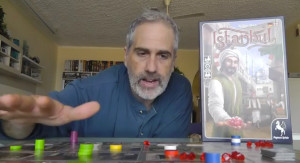
I know you probably get asked this a lot, but what is your favorite game at the moment? Do you have any “guilty pleasure” games, like Monopoly? 🙂
Well my favourite game of all time is Agricola, but “of the moment” status probably goes to Spyrium, which got totally robbed for this year’s Kennerspiel! Or maybe SOS Titanic. Hmm, tough one…
As for guilty pleasures… games I’m actually ashamed to admit I enjoy… can’t think of any! I guess I’m pretty hard to shame!
What are some of your gaming pet peeves, as far as playing the game, and how a game is designed?
It drives me nuts when medium to heavy-weight games don’t come with player aids, and especially when the back cover of the manual isn’t used for a handy reference sheet of some sort. C’mon people! That always seems so short sighted to me! And it drives me nuts when it’s obvious that game designers don’t put as much love and attention into the 2p game play of their games, just doing some quick “hack” like “each player controls two players.”
This is sort of a random question, but one my dad wanted me to ask you. What are your favorite snacks or drinks, if any, to have during gaming sessions?
The most common snacks I go for are a pinch of shredded cheese, or a spoonful of peanut butter. Pretty much the only thing I drink ever is water, or vanilla milkshakes when I’m in the states (can’t get a good one in Europe, I’ve found). That said, Jen and I never really snack when we’re playing games… too intent on the gameplay!
What upcoming games are you most looking forward to?
There’s a bunch: Feld’s new La Isla, Rosenberg’s new Arler Erde, the Zombie sequel to Escape: Curse of the Temple, all the cool new Legends of Andor stuff that FFG keeps refusing to publish (grrr!), the Pandemic dice game, Vital Lacerda’s new Kanban (and Gallerist and Escape Plan), and Consequential, which I’ve been waiting for a couple of years now!
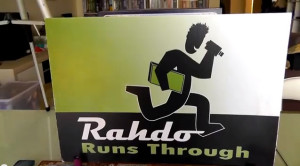
We just reviewed Paperback. It was actually my fist deck builder, and I now want to try some others. Do you think Paperback is a good gateway deck builder? For those interested to try similar games, what do you recommend?
Yeah, it’s fantastic. I would definitely use Paperback as an intro to deckbuilders over Dominion for boardgame muggles, because it’s so accessible. But Dominion is still the best deckbuilder out there for my money, if you’re willing to invest in a few expansions to really round it out. Or Trains if you’re not wanting to buy a lot of expansions, as it’s basically Dominion plus a map. Eminent Domain is fantastic, with the expansion that is, if you’re looking for some great sci fi. Even though it’s a little rough, Shadowrift is still the best co-op deck builder out there
There’s lots of cool hybrid deckbuilders now too, like Concordia, Rococo and Lewis & Clark too, if you’re looking for something a bit “broader.” 🙂
I mentioned in my review that the theme didn’t come through in game play. In general, how important is theme to you?
It’s hugely important to me, BUT I don’t need heavy theme at all. A lot of games that people say are completely themeless feel thematic to me because I’m willing to invest myself into the world they create in a way that a lot of people aren’t. It seems people often don’t think a game is thematic unless they’ve got a little avatar that represents them moving around on the board, but to me, Feld games are very themeatic because I’m not playing someone in the world doing the work, but instead am playing a manager who’s job it is to bring all the various elements together to get things done. As long as the choices I make in game match the kinds of choices I’d make in real life if I were in that circumstance, then it’s thematic to me.
But yeah, Paperback is a pure abstract, all the way, though I do think the Paige Turner stuff is a nice graphic style addition, but not really a theme 🙂
I supported Paperback on Kickstarter – one of the first games I supported, actually. You review a few Kickstarter games on your channel, which is cool. What are your general feelings on Kickstarter? How would you respond to critics who are skeptical of it?
I think Kickstarter is great, and I don’t understand the criticisms at all. It’s a platform that lets individuals pursue their creative dreams, which is awesome, and it’s also a platform that lets boardgame publishers remove a LOT of the risk of producing games as well. It’s all win win win, I don’t understand how anyone could be opposed to it. It literally does not compute!
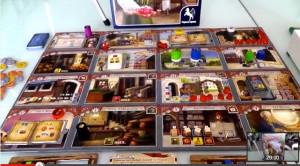
The Geeky Gimp tries to promote accessibility in gaming. What are your general feelings on accessibility in gaming – and not just tabletop games, but video games as well? Do you see any changes occurring? What, if anything, needs to be addressed?
Well, certainly making your games as accessible to as wide a range of players as possible is always worth pursuing, not only because it’s the right thing to do (to try to improve the quality of the lives of our fellow gamers), but also because it’s the SMART thing to do as, frankly, it helps make more money. The last videogame I ever worked on, Brink, got a TON of positive press attention solely because we choose to make our interface colourblind friendly and our controls completely re-mappable on console (which is rarely done). This was very little work for us to do, but it had a HUGE impact for thousands of players, so it was a no brainer. And yet, game after game after game doesn’t bother with these simple tweaks to make their games as accessible as possible (this goes for boardgames too… why is green + red so standard for player markers???) and it boggles my mind! So if you ask what needs to be addressed, I think developer awareness of what they can do more than anything else is what’s needed.
Any final thoughts?
Just thanks for having me on – this was a fun little cross over project, I thought, and I have to say, keep up the good work raising awareness (as I mentioned above). And congrats on acing your finals! 🙂
Thank you again, Richard!

I love your review – you are persnickety without being obnoxious. Your idea of typewriter keys is pure gold! =)
I like your attention to the rules and the “length track” issue. I’ve spent an inordinate amount of time struggling with directions for a light game – part of that is due to trying to make it fit on mini cards and yet be legible! (ooh, a post idea for me – the worth of a technical editor!)
It’s easy to assume others interpret something like “length track” in the way you mean, but that’s a mistake which stands out like a sore thumb.
And very cool about teaming up with Rahdo – he and Jen are reviewers I trust (if any of Erin’s readers haven’t seen Rahdo’s run through of “Escape: The Curse of the Temple” – make a point to watch it and have a fun laugh at how frenetic the game is! =)
http://youtu.be/wvFEj49Q6Z0
Thank you! I like that – persnickety without being obnoxious 🙂 I’m about to post the Paperback videos into this blog, so you can check them out if you haven’t already. Yeah, the length track thing annoyed me, as I was just yelling at the rule book “what length track?! WHAT THE HECK?!” That’s never a good start to a gaming session, haha. But I’m so happy I ended up liking the game. Oh, I loved that episode of Rahdo with Escape: Curse of the Temple. I’d really like to try that game out, though it would be near impossible to play for me. It’s a timed game, and I need help moving pieces, collecting dice after I roll them, etc. I suppose it’s doable, but I suspect it would make the game more hectic than it already is 😉
Glad to find this review! I just played paperback for the first time with friends over the weekend. We loved it – but the instruction booklet is definitely in need of some help. For one thing, my friends and I are all pretty new to gaming – and the instructions seem to assume the player is experienced. Several terms were NOT defined, and some things were kind of left up in the air (I can’t remember specifics right now but I know at least one thing was mentioned once and never again – what are we supposed to do with that?) I think it would benefit from a newbie player going through it with the maker and pointing out where things need to be spelled out better. Other than that, we loved this game, and as you say, saw the potential for some personalized House Rules that we’ll have fun with in the future. One friend has rheumatoid arthritis and she did have trouble handling all those cards (which she had because she beat the pants off the rest of us!) so I’m going to make some card racks for use here and with other games. Fortunately, this group finds “figuring out how the heck to play this game” as one of the fun parts of playing tabletop games!
I’m so glad my review was helpful! Yeah, the rules definitely pandered to the experienced deck builder/gamer. For me, as well, the fun part of gaming is figuring out how to play. Right now, I’m trying to learn Mage Knight, which…well, let’s just say it is MUCH harder than Paperback 😉
I’m hoping to write up a post soon about adaptive game devices, and I’m definitely going to include reviews of some card holders I found.
Thanks for visiting my blog!
OMG! So glad you reviewed this. 🙂 I actually supported the Kickstarter for Burgle Bros which sounded AMAZING! And was wondering about Paperback.
PS Let me know about Mage Knight. It is on my “to buy” list but The Resistance: Avalon, Smash Up, and Race for the Galaxy snuck ahead of it in line. Now I’m just waiting for the next holiday/birthday/celebration for the next game purchase.
Erin, that was an excellent review of Paperback and I also enjoyed the interview with Richard (I just came across your site for the first time thanks to him). Your commentary and perspective are presented in such an informative and entertaining manner, you definitely have a gift as a writer!
I just bookmarked your site and will look forward to your future efforts…
Thanks, Steve! I’m glad you enjoyed my review 🙂 I’ll be uploading a new one hopefully soon!
Just read your review. I received this game for Christmas and we tried to play it using the instructions. Nope. They made no sense. It felt like the bad manuals that used to come with software, etc. You had to buy a XX for Dummies to figure out what the instructions were supposedly saying. Your writeup is definitely helping. Now on to the video.